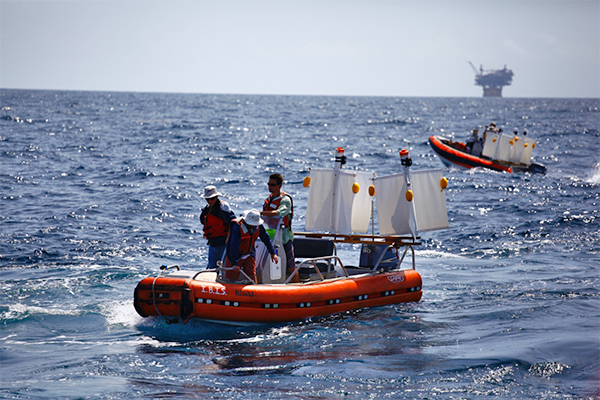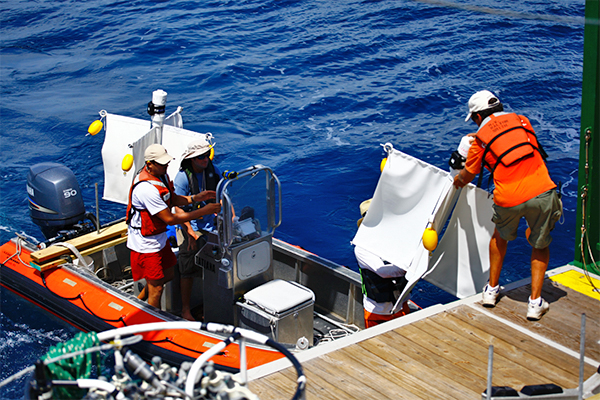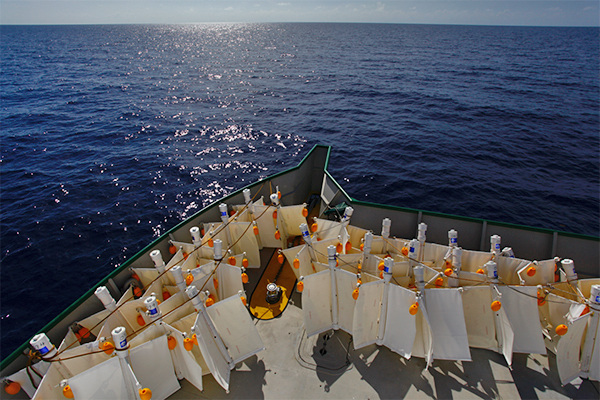


Predicting pollution
UD scientists co-author article on how small-scale ocean currents spread pollutants
9:57 a.m., Aug. 22, 2014--Considered the largest accidental marine oil spill in history, April 2010’s Deepwater Horizon incident in the Gulf of Mexico challenged scientists to think about the way in which oil and other pollutants move in the ocean.
Scientists in the University of Delaware’s College of Earth, Ocean, and Environment (CEOE), in partnership with other researchers, conducted the largest deployment of ocean drifting instruments to date and found that small-scale ocean currents play a major role in the spread of pollutants at the ocean surface.
Research Stories
Chronic wounds
Prof. Heck's legacy
Their findings will help better predict the path of pollutants from future oil spills or nuclear disasters. They provide new information about significant dispersion patterns currently un-accounted for in ocean models.
Observing currents
“The scientific community is very skilled at observing large-scale ocean features, using satellites and other instruments, and forecasting them with ocean models. In this study, we emphasized scales of 100 meters to 10 kilometers. Ocean flow at these scales, which are very small given the vastness of the ocean surface, are poorly understood. That is what we were able to quantify,” said Bruce Lipphardt, research associate professor in CEOE’s School of Marine Science and Policy.
The study, titled “Submesoscale Dispersion in the Vicinity of the Deepwater Horizon Spill,” was published in the Aug. 18 issue of the journal Proceedings of the National Academy of Sciences (PNAS).
Lipphardt, along with fellow CEOE faculty members, Helga Huntley and Denny Kirwan, were co-authors. They are also members of the Consortium for Advanced Research on Transport of Hydrocarbon in the Environment (CARTHE), based at the University of Miami (UM) Rosenstiel School of Marine and Atmospheric Science, which planned and conducted the drifter deployment.
“Our results conclusively show that ocean flows at small scales, below 10 kilometers, contain significant energy fluctuations that control the initial spread of pollutant clouds,” said Tamay Özgökmen, UM Rosenstiel School professor and CARTHE director. “Now that we have quantified this missing piece of the puzzle, we can improve our real-time predictive capabilities in the event of a future oil spill."
Drifting away
For hundreds of years, dropping things into the ocean and watching their movements has been a way for explorers and scientists alike to learn about ocean currents. The use of drifting items in the ocean to monitor currents is not new to the scientific community. Modern “drifters,” however, use on-board GPS sensors to report their positions in real-time via satellite.
“Basically there are two ways of observing the ocean: through observations at fixed geographic points or by tracking the motion of particular particles,” according to Kirwan, CEOE professor emeritus and one of the pioneers of research using ocean drifters.
“In the 1970s projects might have used as many as 70 drifters deployed over the course of a year, taking readings two to four times a day. For this project we had 310 drifters deployed in two weeks, reporting positions every five minutes. We were also analyzing many other measurements made by our ship and satellites. This was an enormous jump in data, making this a truly ‘big data’ project,” Kirwan added.
Testing the waters
The team spent the months leading up to the launch of the drifters conducting computer simulations and virtual experiments, and evaluating launch strategies. “At the small scale, the timing and location of drifter deployments is extremely important, so the planning was critical to get the best results,” said Huntley, CEOE assistant research professor.
In July 2012, researchers embarked on the 12-day at-sea experiment called GLAD (Grand LAgrangian Deployment) to deploy more than 300 GPS-equipped custom drifters in a region where wind-driven continental shelf currents mix with Mississippi River outflow and currents in the Gulf of Mexico.
Lipphardt and other scientists on board the UM Rosenstiel School research vessel F.G. Walton Smith were in routine ship to shore communication with scientists on land, including Kirwan and Huntley, giving estimates for the most opportune times and location for launching.
This was a new way of conducting experiments for the team. “We didn’t know exactly where we wanted to go when the ship departed because these small-scale scenarios are so much more variable. This was an ‘adaptive sampling project’ that took a lot of coordination,” explained Lipphardt.
The drifters flowed along the Gulf of Mexico currents for several months after deployment, capturing a multidimensional picture of the upper-ocean movements in the presence of wind and waves in and around DeSoto Canyon, the site of the Deepwater Horizon oil spill.
The UD team played a major role in data quality control and analysis.
“With so many drifters out at once, the size of the dataset (more than five million drifter positions), required new ways to gather, check, and synthesize it,” Huntley added.
“This experiment is helping to answers questions that arise in all major oil spills, such as ‘where will the oil go?’ and ‘how fast will it get there?’ which are important when allocating limited response resources and determining the overall socio-economic impact of the spill,” said Özgökmen.
About GLAD and CARTHE
The GLAD experiment was made possible by a grant from the Gulf of Mexico Research Initiative (GoMRI).
The GoMRI is a 10-year, $500 million independent research program established by an agreement between BP and the Gulf of Mexico Alliance to study the effects of the Deepwater Horizon incident and the potential associated impact of this and similar incidents on the environment and public health.
The CARTHE program includes 26 principal investigators from 14 research institutions in eight states. Together these scientists are engaged in novel research through the development of a suite of integrated models and state-of-the-art computations that bridge the scale gap between existing models and natural processes.
About UD’s College of Earth, Ocean, and Environment
UD’s College of Earth, Ocean, and Environment (CEOE) strives to reach a deeper understanding of the planet and improve stewardship of environmental resources. CEOE faculty and students examine complex information from multiple disciplines with the knowledge that science and society are firmly linked and solutions to environmental challenges can be synonymous with positive economic impact.
The college comprises the School of Marine Science and Policy, Department of Geography and Department of Geological Sciences.
CEOE brings the latest advances in technology to bear on both teaching and conducting ocean, earth and atmospheric research. Current focus areas are ecosystem health and society, environmental observing and forecasting, and renewable energy and sustainability.
Article by Katy O’Connell, adapted with permission from CARTHE
Photos by Tamay Özgökmen










